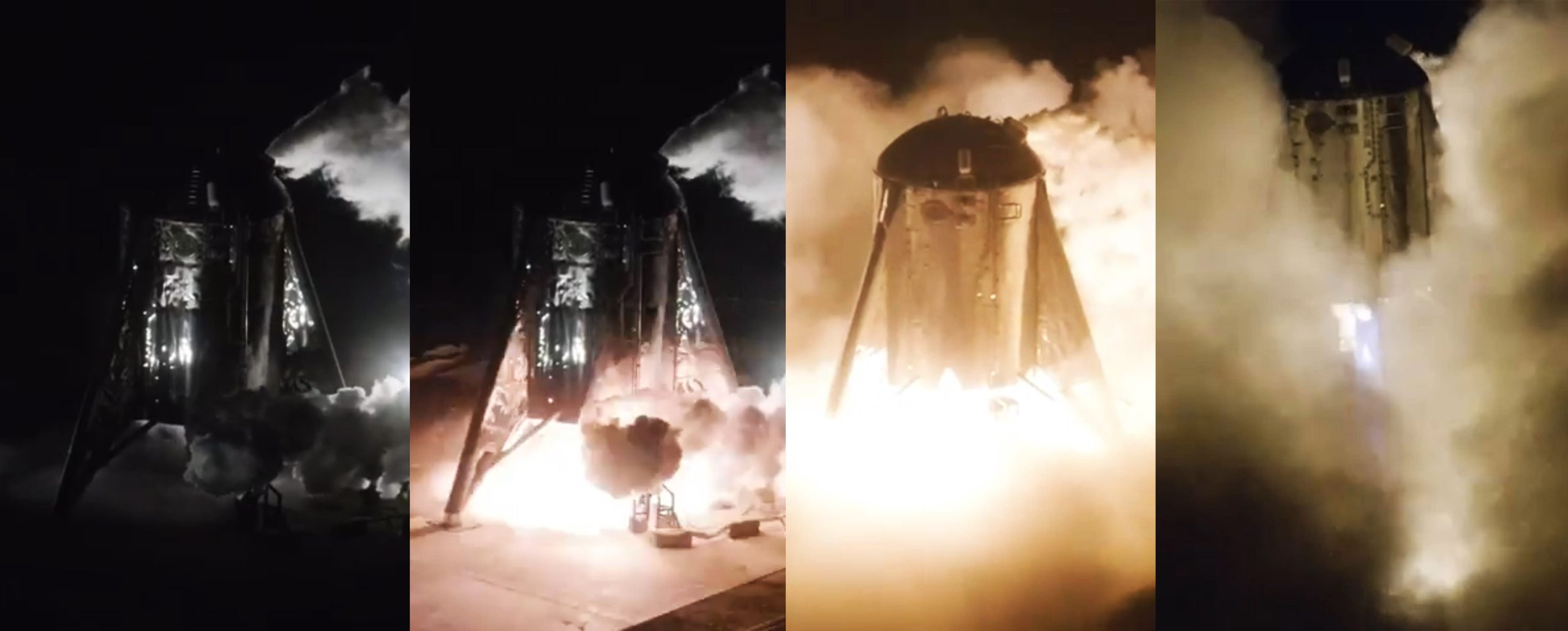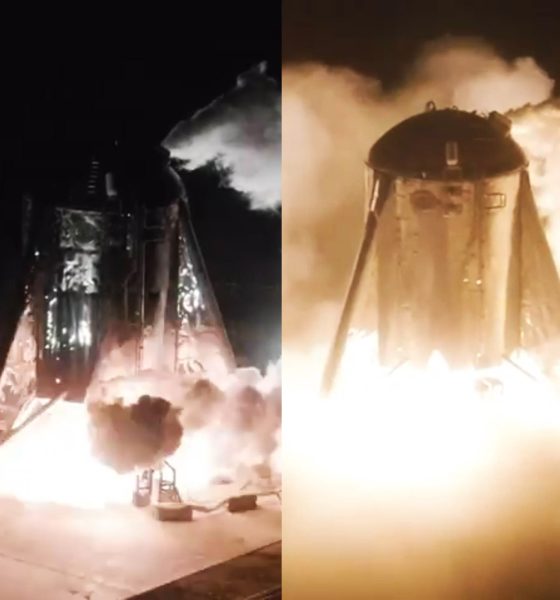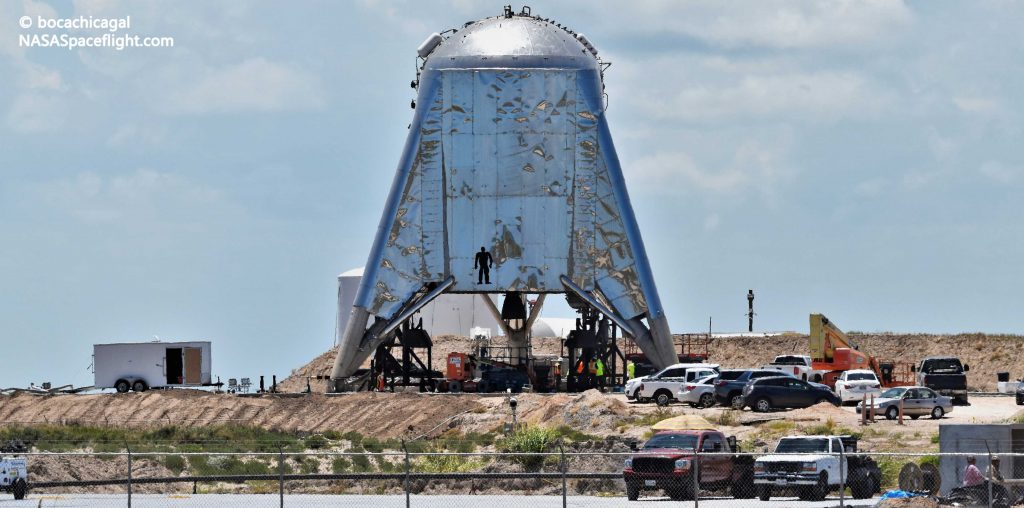

News
SpaceX’s Starhopper cleared by FAA for second and final flight test as locals urged to exit homes
After a full two weeks spent waiting for an FAA permit, SpaceX CEO Elon Musk and local South Texas authorities appear to be preparing Starhopper for a second major flight test as early as Monday, August 26th.
Assuming the FAA comes through with a permit, Starhopper is scheduled to lift off no earlier than 5pm EDT (21:00 UTC) on August 26th for a flight test expected to smash the low-fidelity Starship prototype’s previously altitude record of ~20m (65 ft). Confirming initial reports from NASASpaceflight.com, Musk also stated that Starhopper’s second flight will be its last, after which the steel rocket test-bed will be converted for stationary use at SpaceX’s South Texas facilities.
Prior to Musk tweeting that Starhopper may be nearing approval for its next flight, the SpaceX CEO revealed that delays were centered around the FAA’s apparent unwillingness to permit the vehicle’s next flight. Musk specifically stated that the FAA wanted more “hazard analysis”, meaning that the US aviation administration had concerns that Starhopper could pose a serious threat to local residents in a tiny housing development known as Boca Chica Village.
Technically speaking, Boca Chica Village is just 1.5 miles (2.4 km) away from SpaceX’s Starhopper launch facilities, where the vehicle is expected to reach a maximum altitude of no more than 200m (650 ft) as early as August 26th. FAA regulations tend to be prescriptive and extremely rigid, understandable given the breadth of US aviation-related activities the agency is tasked with regulating. However, a basic back-of-the-envelope analysis of Starhopper’s 200m hop suggests that the risk to local residents – even those as few as 1.5 miles away from the test – is minuscule.
Based on Starhopper’s inaugural flight, its lone Raptor engine – producing up to 200 tons (450,000 lbf) of thrust – is not exactly capable of rapidly moving the Starship prototype. For all accounts and purposes, Starhopper is a spectacularly heavy hunk of steel with the aerodynamics of a cylindrical brick – capable of flight solely through the brute-force application of a literal rocket engine. To make it even half of the distance from its launch site to the Village, Starhopper would have to remain in controlled flight while radically deviating from its planned trajectory, all while its flight termination system (FTS) – explosives meant to destroy the vehicle in a worst-case scenario – completely fails to activate.

As evidence of the apparent lack of perceived risk to local residents, Cameron County, Texas officials distributed flyers to Village residents advising – but not requiring – those choosing to remain at their homes during the test to go outside during Starhopper’s next flight. This is recommended to avoid flying glass in the event that the vehicle explodes, potentially shattering windows with the shockwave that could result, but clearly demonstrates the fact that county officials believe there is a near-zero chance of Starhopper actually impacting anywhere near the houses.
Ultimately, Starhopper’s limited flight tests clearly pose little to no actual risk to residents, but this chapter does raise a far more significant question: what happens once Starship Mk1 is ready and the flight tests SpaceX is pursuing involve distances and heights on the order of several, tens, or hundreds of kilometers? For now, answers will have to wait til a later date.
A Hop and a skip into retirement
Aside from the delays and apparent lack of consensus on the safety of Starhopper’s minor hop tests, Musk confirmed that the prototype’s second test flight ever will likely be its last, providing some interesting insight into SpaceX’s next steps. Most notably, the fact that SpaceX is willing and ready to fully retire Starhopper after such a limited test series serves as a fairly confident statement that orbital-class Starship Mk1 (Texas) and Mk2 (Florida) prototypes are extremely close to flight-readiness.
Roughly a month ago, Musk tweeted that those Starship prototypes could be ready for their first flights as early as mid-September to mid-October, “2 to 3 months” from mid-July. In additional comments made on August 20th, Musk stated that his planned Starship presentation would be delayed in light of Starhopper’s own delays, and is now instead expected to occur around a major Starship Mk1 integration milestone in “mid September”.
As previously discussed on Teslarati, Starhopper’s brief service life is entirely unsurprising, delayed by issues with Raptor engines to the point that SpaceX’s far more valuable Starship prototypes – having made relentless progress – are already nearing completion. Once those Starships are ready for almost any kind of integrated testing, Starhopper will be made entirely and immediately redundant.
“According to Musk, either or both of those orbital-class prototypes could be ready for their inaugural flight tests as early as mid-September, perhaps just 1-2 months from now. Given that Starships Mk1 and Mk2 are significantly higher fidelity than Starhopper, the ungainly testbed will likely become redundant the moment that its successors are ready for flight. In other words, Starhopper is fast approaching the end of its useful life, and SpaceX’s fight for a 200m hop-test permit could ultimately be a waste of time, effort, and money if said permit doesn’t also cover Starship Mk1.”
Teslarati.com, August 20th, 2019
On another positive note, CEO Elon Musk says that Starhopper won’t be ‘retired’ to the scrapyard and will instead be lightly modified to serve as an in-situ test stand for Raptor engines, a useful addition once SpaceX South Texas moves on to multi-engine Starship and Super Heavy testing.
With any luck, SpaceX will attempt to livestream Starhopper’s second attempted flight. Stay tuned for updates on the 5pm EDT, August 26th test.
Check out Teslarati’s Marketplace! We offer Tesla accessories, including for the Tesla Cybertruck and Tesla Model 3.

News
Tesla FSD fleet is nearing 7 billion total miles, including 2.5 billion city miles
As can be seen on Tesla’s official FSD webpage, vehicles equipped with the system have now navigated over 6.99 billion miles.

Tesla’s Full Self-Driving (Supervised) fleet is closing in on almost 7 billion total miles driven, as per data posted by the company on its official FSD webpage.
These figures hint at the massive scale of data fueling Tesla’s rapid FSD improvements, which have been quite notable as of late.
FSD mileage milestones
As can be seen on Tesla’s official FSD webpage, vehicles equipped with the system have now navigated over 6.99 billion miles. Tesla owner and avid FSD tester Whole Mars Catalog also shared a screenshot indicating that from the nearly 7 billion miles traveled by the FSD fleet, more than 2.5 billion miles were driven inside cities.
City miles are particularly valuable for complex urban scenarios like unprotected turns, pedestrian interactions, and traffic lights. This is also the difference-maker for FSD, as only complex solutions, such as Waymo’s self-driving taxis, operate similarly on inner-city streets. And even then, incidents such as the San Francisco blackouts have proven challenging for sensor-rich vehicles like Waymos.
Tesla’s data edge
Tesla has a number of advantages in the autonomous vehicle sector, one of which is the size of its fleet and the number of vehicles training FSD on real-world roads. Tesla’s nearly 7 billion FSD miles then allow the company to roll out updates that make its vehicles behave like they are being driven by experienced drivers, even if they are operating on their own.
So notable are Tesla’s improvements to FSD that NVIDIA Director of Robotics Jim Fan, after experiencing FSD v14, noted that the system is the first AI that passes what he described as a “Physical Turing Test.”
“Despite knowing exactly how robot learning works, I still find it magical watching the steering wheel turn by itself. First it feels surreal, next it becomes routine. Then, like the smartphone, taking it away actively hurts. This is how humanity gets rewired and glued to god-like technologies,” Fan wrote in a post on X.
News
Tesla starts showing how FSD will change lives in Europe
Local officials tested the system on narrow country roads and were impressed by FSD’s smooth, human-like driving, with some calling the service a game-changer for everyday life in areas that are far from urban centers.

Tesla has launched Europe’s first public shuttle service using Full Self-Driving (Supervised) in the rural Eifelkreis Bitburg-Prüm region of Germany, demonstrating how the technology can restore independence and mobility for people who struggle with limited transport options.
Local officials tested the system on narrow country roads and were impressed by FSD’s smooth, human-like driving, with some calling the service a game-changer for everyday life in areas that are far from urban centers.
Officials see real impact on rural residents
Arzfeld Mayor Johannes Kuhl and District Administrator Andreas Kruppert personally tested the Tesla shuttle service. This allowed them to see just how well FSD navigated winding lanes and rural roads confidently. Kruppert said, “Autonomous driving sounds like science fiction to many, but we simply see here that it works totally well in rural regions too.” Kuhl, for his part, also noted that FSD “feels like a very experienced driver.”
The pilot complements the area’s “Citizen Bus” program, which provides on-demand rides for elderly residents who can no longer drive themselves. Tesla Europe shared a video of a demonstration of the service, highlighting how FSD gives people their freedom back, even in places where public transport is not as prevalent.
What the Ministry for Economic Affairs and Transport says
Rhineland-Palatinate’s Minister Daniela Schmitt supported the project, praising the collaboration that made this “first of its kind in Europe” possible. As per the ministry, the rural rollout for the service shows FSD’s potential beyond major cities, and it delivers tangible benefits like grocery runs, doctor visits, and social connections for isolated residents.
“Reliable and flexible mobility is especially vital in rural areas. With the launch of a shuttle service using self-driving vehicles (FSD supervised) by Tesla in the Eifelkreis Bitburg-Prüm, an innovative pilot project is now getting underway that complements local community bus services. It is the first project of its kind in Europe.
“The result is a real gain for rural mobility: greater accessibility, more flexibility and tangible benefits for everyday life. A strong signal for innovation, cooperation and future-oriented mobility beyond urban centers,” the ministry wrote in a LinkedIn post.
News
Tesla China quietly posts Robotaxi-related job listing
Tesla China is currently seeking a Low Voltage Electrical Engineer to work on circuit board design for the company’s autonomous vehicles.

Tesla has posted a new job listing in Shanghai explicitly tied to its Robotaxi program, fueling speculation that the company is preparing to launch its dedicated autonomous ride-hailing service in China.
As noted in the listing, Tesla China is currently seeking a Low Voltage Electrical Engineer to work on circuit board design for the company’s autonomous vehicles.
Robotaxi-specific role
The listing, which was shared on social media platform X by industry watcher @tslaming, suggested that Tesla China is looking to fill the role urgently. The job listing itself specifically mentions that the person hired for the role will be working on the Low Voltage Hardware team, which would design the circuit boards that would serve as the nervous system of the Robotaxi.
Key tasks for the role, as indicated in the job listing, include collaboration with PCB layout, firmware, mechanical, program management, and validation teams, among other responsibilities. The role is based in Shanghai.
China Robotaxi launch
China represents a massive potential market for robotaxis, with its dense urban centers and supportive policies in select cities. Tesla has limited permission to roll out FSD in the country, though despite this, its vehicles have been hailed as among the best in the market when it comes to autonomous features. So far, at least, it appears that China supports Tesla’s FSD and Robotaxi rollout.
This was hinted at in November, when Tesla brought the Cybercab to the 8th China International Import Expo (CIIE) in Shanghai, marking the first time that the autonomous two-seater was brought to the Asia-Pacific region. The vehicle, despite not having a release date in China, received a significant amount of interest among the event’s attendees.








